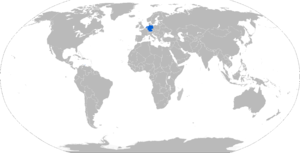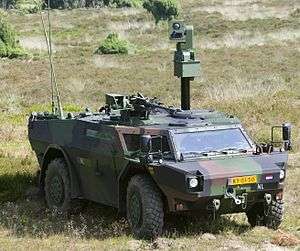Fennek
| LGS Fennek | |
|---|---|
|
Royal Netherlands Army Fennek | |
| Type | Light armored reconnaissance vehicle |
| Place of origin |
|
| Specifications | |
| Weight | 9.7-10.4 tonnes |
| Length | 5.71 m |
| Width | 2.49 m |
| Height | 1.79 m |
| Crew | 3 |
|
| |
Main armament | HK GMG 40 mm grenade autocannon or Rheinmetall MG3 (German version), M2HB 12.7 mm machine gun (Dutch versions) |
Secondary armament | Not applicable |
| Engine |
Deutz diesel 179 kW (239 hp) |
| Power/weight | 18.5 kW/tonne |
| Suspension | Selectable 4 wheel drive |
Operational range | 860 km |
| Speed | 115 km/h |
The Fennek, named after the fennec (a species of small desert fox), or LGS Fennek, with LGS being short for Leichter Gepanzerter Spähwagen in German (Light Armoured Reconnaissance Vehicle), is a four-wheeled armed reconnaissance vehicle produced by the German company Krauss-Maffei Wegmann and Dutch Defence Vehicle Systems.[1] The Turkish company FNSS Defence Systems acquired the right for licence production in 2004.[2][3][4] It was developed for both the German Army and Royal Netherlands Army to replace their current vehicles.
History
In April 2000, the prototype vehicle finished field trials and in December 2001 a combined order was placed. 410 were ordered by the Royal Netherlands Army (202 reconnaissance, 130 MRAT (medium range antitank) and 78 general purpose versions) and 222 by the German military (178 reconnaissance, 24 combat engineer, 20 joint fire support teams (JFST)). More Fenneks for the German Army will be procured from 2015 on. Germany plans an overall purchase of approximately 300 Fenneks. The first vehicle was delivered to the Netherlands in July 2003[5] and the first to Germany in December of the same year. Deliveries will continue until 2011 (additional orders for the German Army are planned from 2015 on).
The Dutch SP Aerospace company, which produced the Fennek for the Dutch military, was declared bankrupt in August 2004. A new company called Dutch Defence Vehicle Systems (DDVS)[6] was created to continue the production of the vehicles for the Royal Netherlands Army.
Specifications
The Fennek has four wheels with selectable two or four wheel drive. It has a Deutz diesel engine producing 179 kW, giving it a top speed of 115 km/h. Tire pressure can be regulated by the driver from inside the vehicle to suit terrain conditions.
The primary mission equipment is an observation package mounted on an extendable mast. Sensors include a thermal imager, daylight camera and a laser rangefinder. Combined with the vehicle's GPS and inertial navigation system the operator can accurately mark targets or points of interest and pass that data to the digital battlefield network. The sensor head of the observation package can also be removed and mounted on a tripod for concealed operation, as can the control unit from the vehicle should the crew want to use the entire system dismounted.[7] Many Fenneks of the German Army are also equipped with Aladin miniature UAVs.
Various weapons can be fitted, such as a 12.7 mm machine gun for the Dutch reconnaissance version, a Rafael Spike anti-tank missile on the Dutch MRAT version or a 40 mm automatic grenade launcher (HK GMG) or Rheinmetall MG3 for the German vehicles. The Royal Netherlands Army also placed an order at the Turkish company Aselsan for 18 Raytheon Stinger surface-to-air missile launchers to be fitted on the Fennek. The launcher in this case is the Stinger Weapon Platform (SWP), with four Stinger missiles intended for mid-range air defence. The launcher can be controlled from on board the vehicle, or else remotely as part of a distributed air defense system. On the Dutch Fennek the primary weapon is the 12.7 mm machine gun.
The vehicle is protected all-round against 7.62 mm rounds and additional armour can be added if the mission requires. The air conditioning system provides protection against nuclear, biological and chemical warfare and the crew compartment is protected against anti-personnel mines.[8]
Operational history
Both Germany and the Netherlands have deployed Fennek reconnaissance vehicles to Afghanistan in support of ISAF.[9] On 3 November 2007 a Dutch Fennek was hit by an improvised explosive device killing one and wounding two other occupants. The vehicle and its crew were taking part in an offensive operation targeting the Taliban in the province of Uruzgan, Afghanistan.[10] In another incident a German Fennek was hit by a rocket-propelled grenade.[11] Its hollow charge jet penetrated the vehicle through the right front wheel rim, passed through the vehicle and blew the left door off the hinge. Thanks to the spall liner the crew sustained only negligible injuries.
Operators

Current operators
-
 Germany
Germany
- German Army - 222, to be increased to 248[12]
-
 Netherlands
Netherlands
Future operators
Gallery
.jpg) A Fennek and an ATF Dingo of the German Army in Afghanistan
A Fennek and an ATF Dingo of the German Army in Afghanistan German Fenneks in Afghanistan (2009)
German Fenneks in Afghanistan (2009) Side-view of a German Fennek
Side-view of a German Fennek Royal Netherlands Army Fennek
Royal Netherlands Army Fennek Ignition of the smoke grenade launchers of a German Army Fennek
Ignition of the smoke grenade launchers of a German Army Fennek Heckler & Koch GMG on board a German Army Fennek
Heckler & Koch GMG on board a German Army Fennek
See also
References
- ↑
- ↑ "Cooperation between Krauss-Maffei Wegmann, Germany and FNSS,Turkey for the licensed production of the FENNEK vehicle in Turkey". defense-aerospace.com. defense-aerospace.com. Retrieved 25 September 2015.
- ↑ http://www.deagel.com/Tactical-Vehicles/Fennek_a000313001.aspx
- ↑ http://www.ssm.gov.tr/katalog2007/tr/urunler.html
- ↑ Fennek Delivery Details
- ↑
- ↑ Fennek Observation Details
- ↑ Fennek Self Protection Details
- ↑ FENNEK Highly protected vehicle family Krauss-Maffei Wegmann & Co. KG
- ↑ First Fennek Lost in IED Attack AVIATION WEEK, 11/5/2007
- ↑ Rocket Propelled Grenade Attack Details
- ↑ "Großgerät der Bundeswehr". Bundeswehr.de (in German). Berlin: German Armed Forces. 2015-10-22. Retrieved 12 November 2015.
- ↑ "Fennek-verkenningsvoertuig". Defensie.nl (in Dutch). Dutch Ministry of Defence. Retrieved 12 November 2015.
- ↑ Nkala, Oscar. "Germany approves export of military vehicles, small arms to Algeria". Defenceweb. Retrieved 12 November 2015.
External links
| Wikimedia Commons has media related to Fennek reconnaissance vehicles. |
- Dutch Cavalry Museum has a prototype of the Fennek in its collection
